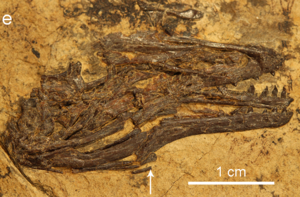Longusunguis
| Longusunguis | ||||||||
|---|---|---|---|---|---|---|---|---|

Fossil skull of a Longusunguis kurochkini |
||||||||
| Temporal occurrence | ||||||||
| Lower Cretaceous ( Aptium ) | ||||||||
| approx. 120.4 million years | ||||||||
| Locations | ||||||||
| Systematics | ||||||||
|
||||||||
| Scientific name | ||||||||
| Longusunguis | ||||||||
| Wang , Zhou , O'Connor & Zelenkov , 2014 | ||||||||
| Art | ||||||||
|
||||||||
Longusunguis is an extinct genus of the Enantiornithes (Bohaiornithidae) . The generic name is derived from the Latin longus ("lang") and unguis ("claw") and refers to the claws on the foot.
The only known species is called Longusunguis kurochkini . The species name honors the late palaeontologist Prof. Yevgeny Nikolayevich Kurochkin , who mainly dealt with fossil birds and was regarded as the world's leading expert.
It was named and described in 2014 by Min Wang, Zhong-He Zhou , Jingmai K. O'Connor and Nikita V. Zelenkov.
remains
The fossil (holotype IVPP V17964) was discovered in the Jiufotang Formation , which is in what is now China. It is estimated to be around 120.3 million years old and is therefore in the Lower Cretaceous ( Aptian ). The specimen consists of a complete and articulated skeleton with a skull . The holotype is kept on a single plate and is currently at the Institute of Vertebrate Paleontology and Paleoanthropology (IVPP) in Beijing.
He is 15 to 20 cm tall. Bone examinations showed that the specimen had not yet reached skeletal maturity . The upper jaw bone has an additional opening. The approximately 34 mm long skull is directed forward. It has four teeth on the intermaxillary bone, the foremost of which are smaller. There are six teeth in the lower jaw. They are robust, flattened, dagger-shaped, pointed, and curved backwards. The pygostyle is longer than the metatarsus.